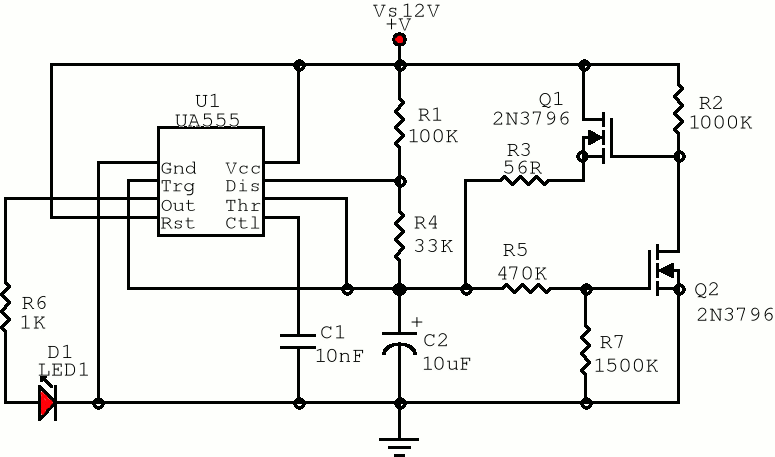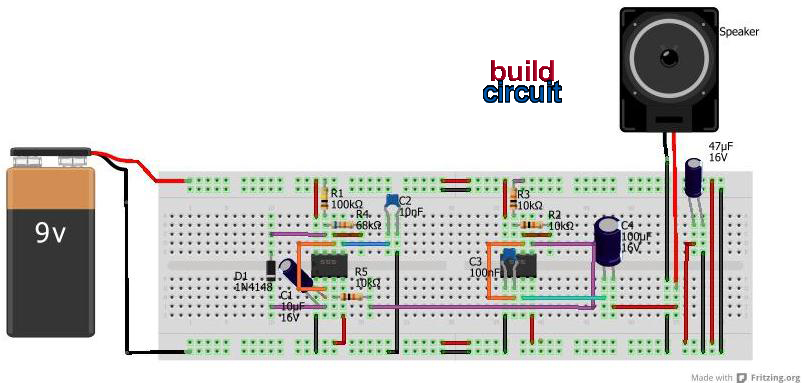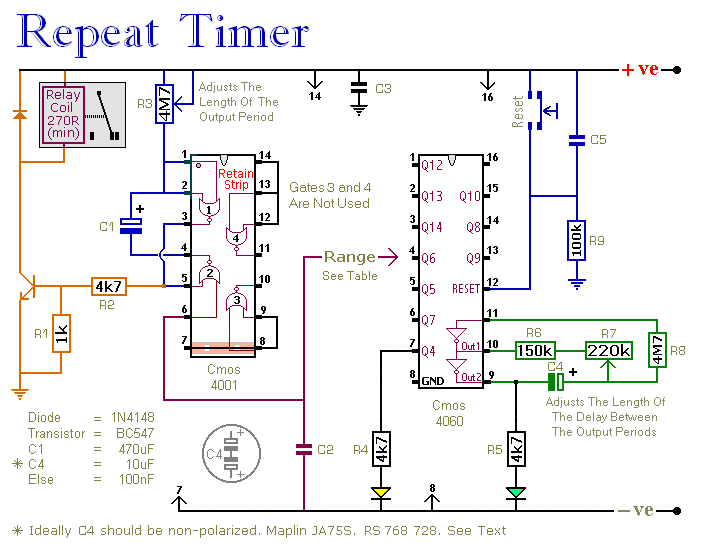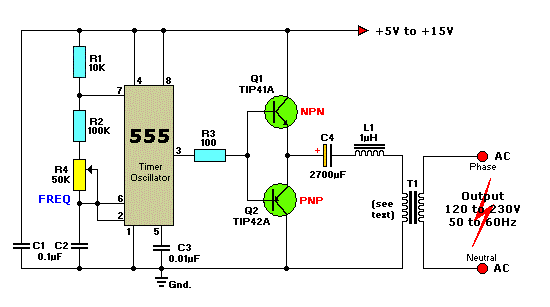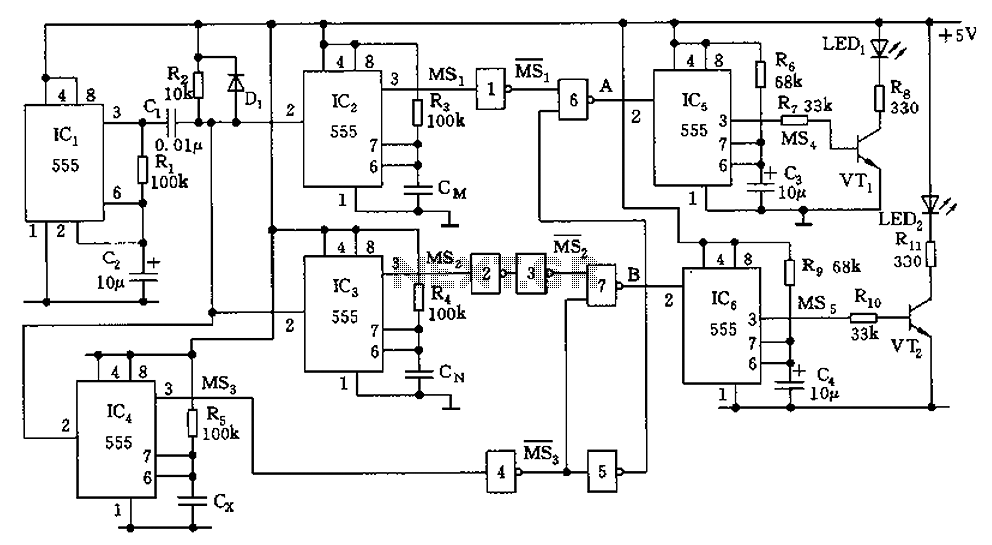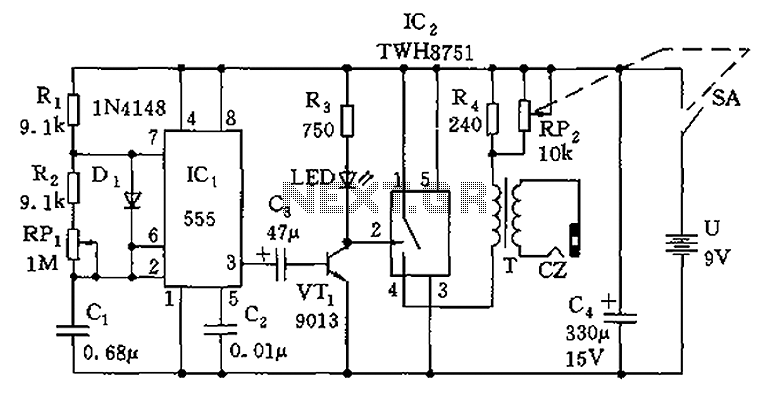
555 Timer as Monostable Multivibrator
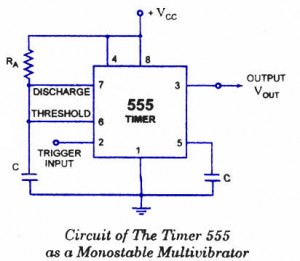
A monostable multivibrator (MMV), commonly referred to as a one-shot multivibrator, is a pulse generator circuit where the pulse duration is determined by an externally connected resistor-capacitor (R-C) network to a 555 timer. In this configuration, one output state is stable, while the other is quasi-stable (unstable). To trigger the output from the quasi-stable state to the stable state, energy is stored in an external capacitor (C) to a reference level, and the time required for this storage dictates the pulse width. The transition from the stable state to the quasi-stable state is initiated by an external trigger. The schematic for a 555 timer operating in monostable mode includes specific pin connections: Pin 1 is grounded; pins 4 and 8 are connected to the supply voltage (+Vcc); the output (VOUT) is taken from pin 3; pins 2 and 6 are shorted and connected to ground through capacitor C; pin 7 is connected to +Vcc through resistor RA, with resistor RB positioned between pins 6 and 7. A bypass capacitor of 0.01 µF may be connected to pin 5, or a modulation input may be applied. The trigger input is applied to pin 2, which remains at +Vcc during quiescent conditions. To transition the output from stable to quasi-stable, a negative-going pulse with a width smaller than the expected output pulse width and an amplitude greater than +2/3 Vcc is applied to pin 2. The output is taken from pin 3, while pin 4 is usually connected to +Vcc to prevent accidental reset. Pin 5 is grounded through a 0.01 µF capacitor to mitigate noise issues. Pin 6 (threshold) is connected to pin 7, and a resistor RA connects pins 6 and 8. A discharge capacitor is connected to pin 7, which is also connected to the supply Vcc. Initially, when the output at pin 3 is low (indicating a stable state), the transistor is on, and capacitor C is shorted to ground. When a negative pulse is applied to pin 2, the trigger input drops below +1/3 Vcc, causing the comparator output to go high, resetting the flip-flop, turning off the transistor, and raising the output at pin 3 to high. This transition signifies a shift from stable to quasi-stable state. As the discharge transistor turns off, capacitor C begins to charge towards +Vcc through resistor RA, with a time constant equal to RAC. When the voltage across the capacitor exceeds +2/3 Vcc, the output of comparator 1 goes high, setting the flip-flop, saturating the transistor, discharging capacitor C, and driving the timer output low. The output of the monostable multivibrator remains low until another trigger pulse is applied, at which point the cycle repeats. The waveforms for the trigger input, output voltage, and capacitor voltage are illustrated in accompanying figures, where RA is in ohms and C is in farads. The pulse width of this circuit can range from microseconds to several seconds, making it widely utilized in various industrial timing applications.
The monostable multivibrator (MMV) circuit utilizing the 555 timer is a highly versatile component in electronic design, particularly for applications requiring precise timing and pulse generation. The configuration of the 555 timer in monostable mode allows for a single output pulse in response to a triggering event, making it suitable for tasks such as time delays, pulse width modulation, and generating clock signals.
In practical applications, the choice of the resistor (RA) and capacitor (C) values is critical, as they directly influence the pulse width of the output signal. The relationship governing the output pulse width (T) is typically expressed as:
\[ T = 1.1 \times RA \times C \]
This equation highlights the linear dependence on both the resistance and capacitance, allowing designers to tailor the timing characteristics to meet specific requirements. The selection of components should consider tolerance, temperature stability, and the frequency response of the circuit to ensure reliable operation under varying conditions.
The robustness of the 555 timer in monostable mode is further enhanced by the addition of bypass capacitors at pin 5, which helps to filter out noise that could inadvertently trigger the output. The careful grounding of pin 1 ensures a stable reference point for the circuit, minimizing the risk of erroneous behavior.
In summary, the monostable multivibrator circuit exemplifies a fundamental electronic building block that can be adapted for a wide range of timing applications, from simple delay circuits to complex pulse generation systems, demonstrating its enduring relevance in modern electronics.A monostable multivibrator (MMV) often called a one-shot multivibrator, is a pulse generator circuit in which the duration of the pulse is determined by the R-C network, connected externally to the 555 timer. In such a vibrator, one state of output is stable while the other is quasi-stable (unstable). For auto-triggering of output from quasi-stable state to stable state energy is stored by an externally connected capaci tor C to a reference level. The time taken in storage determines the pulse width. The transition of output from stable state to quasi-stable state is accom plished by external triggering.
The schematic of a 555 timer in monostable mode of operation is shown in figure. Pin 1 is grounded; pins 4 and 8 are shorted and then tied to supply +Vcc, output (VOUT is taken form pin 3; pin 2 and 6 are shorted and the connected to ground through capacitor C, pin 7 is connected to supply + VCC through a resistor RA; and between pin 6 and 7 a resistor RB is connected. At pin 5 either a bypass capacitor of 0. 01 F is connected or modulation input is applied. Pin 1 is grounded. Trigger input is applied to pin 2. In quiescent condition of output this input is kept at + VCC. To obtain transition of output from stable state to quasi-stable state, a negative-going pulse of narrow width (a width smaller than expected pulse width of output waveform) and amplitude of greater than + 2/3 VCC is applied to pin 2.
Output is taken from pin 3. Pin 4 is usually connected to + VCC to avoid accidental reset. Pin 5 is grounded through a 0. 01 u F capacitor to avoid noise problem. Pin 6 (threshold) is shorted to pin 7. A resistor RA is connected between pins 6 and 8. At pins 7 a discharge capacitor is connected while pin 8 is connected to supply VCC. Initially, when the output at pin 3 is low i. e. the circuit is in a stable state, the transistor is on and capacitor- C is shortedto ground. When a negative pulse is applied to pin 2, the trigger input falls below +1/3 VCC, the output of comparator goes high which resets the flip-flop and consequently the transistor turns off and the output at pin 3 goes high. This is the transition of the output from stable to quasi-stable state, as shown in figure. As the discharge transistor is cut off, the capacitor C begins charging toward +VCC through resistance RA with a time constant equal to RAC.
When the increasing capacitor voltage becomes slightly greater than +2/3 VCC, the output of comparator 1 goes high, which sets the flip-flop. The transistor goes to saturation, thereby discharging the capacitor C and the output of the timer goes low, as illustrated in figure.
The output of the Monostable Multivibrator remains low until a trigger pulse is again applied. Then the cycle repeats. Trigger input, output voltage and capacitor voltage waveforms are shown in figure. where RA is in ohms and C is in farads. The above relation is derived as below. Voltage across the capacitor at any instant during charging period is given as The pulse width of the circuit may range from micro-seconds to many seconds. This circuit is widely used in industry for many different timing applications. 🔗 External reference
The monostable multivibrator (MMV) circuit utilizing the 555 timer is a highly versatile component in electronic design, particularly for applications requiring precise timing and pulse generation. The configuration of the 555 timer in monostable mode allows for a single output pulse in response to a triggering event, making it suitable for tasks such as time delays, pulse width modulation, and generating clock signals.
In practical applications, the choice of the resistor (RA) and capacitor (C) values is critical, as they directly influence the pulse width of the output signal. The relationship governing the output pulse width (T) is typically expressed as:
\[ T = 1.1 \times RA \times C \]
This equation highlights the linear dependence on both the resistance and capacitance, allowing designers to tailor the timing characteristics to meet specific requirements. The selection of components should consider tolerance, temperature stability, and the frequency response of the circuit to ensure reliable operation under varying conditions.
The robustness of the 555 timer in monostable mode is further enhanced by the addition of bypass capacitors at pin 5, which helps to filter out noise that could inadvertently trigger the output. The careful grounding of pin 1 ensures a stable reference point for the circuit, minimizing the risk of erroneous behavior.
In summary, the monostable multivibrator circuit exemplifies a fundamental electronic building block that can be adapted for a wide range of timing applications, from simple delay circuits to complex pulse generation systems, demonstrating its enduring relevance in modern electronics.A monostable multivibrator (MMV) often called a one-shot multivibrator, is a pulse generator circuit in which the duration of the pulse is determined by the R-C network, connected externally to the 555 timer. In such a vibrator, one state of output is stable while the other is quasi-stable (unstable). For auto-triggering of output from quasi-stable state to stable state energy is stored by an externally connected capaci tor C to a reference level. The time taken in storage determines the pulse width. The transition of output from stable state to quasi-stable state is accom plished by external triggering.
The schematic of a 555 timer in monostable mode of operation is shown in figure. Pin 1 is grounded; pins 4 and 8 are shorted and then tied to supply +Vcc, output (VOUT is taken form pin 3; pin 2 and 6 are shorted and the connected to ground through capacitor C, pin 7 is connected to supply + VCC through a resistor RA; and between pin 6 and 7 a resistor RB is connected. At pin 5 either a bypass capacitor of 0. 01 F is connected or modulation input is applied. Pin 1 is grounded. Trigger input is applied to pin 2. In quiescent condition of output this input is kept at + VCC. To obtain transition of output from stable state to quasi-stable state, a negative-going pulse of narrow width (a width smaller than expected pulse width of output waveform) and amplitude of greater than + 2/3 VCC is applied to pin 2.
Output is taken from pin 3. Pin 4 is usually connected to + VCC to avoid accidental reset. Pin 5 is grounded through a 0. 01 u F capacitor to avoid noise problem. Pin 6 (threshold) is shorted to pin 7. A resistor RA is connected between pins 6 and 8. At pins 7 a discharge capacitor is connected while pin 8 is connected to supply VCC. Initially, when the output at pin 3 is low i. e. the circuit is in a stable state, the transistor is on and capacitor- C is shortedto ground. When a negative pulse is applied to pin 2, the trigger input falls below +1/3 VCC, the output of comparator goes high which resets the flip-flop and consequently the transistor turns off and the output at pin 3 goes high. This is the transition of the output from stable to quasi-stable state, as shown in figure. As the discharge transistor is cut off, the capacitor C begins charging toward +VCC through resistance RA with a time constant equal to RAC.
When the increasing capacitor voltage becomes slightly greater than +2/3 VCC, the output of comparator 1 goes high, which sets the flip-flop. The transistor goes to saturation, thereby discharging the capacitor C and the output of the timer goes low, as illustrated in figure.
The output of the Monostable Multivibrator remains low until a trigger pulse is again applied. Then the cycle repeats. Trigger input, output voltage and capacitor voltage waveforms are shown in figure. where RA is in ohms and C is in farads. The above relation is derived as below. Voltage across the capacitor at any instant during charging period is given as The pulse width of the circuit may range from micro-seconds to many seconds. This circuit is widely used in industry for many different timing applications. 🔗 External reference
